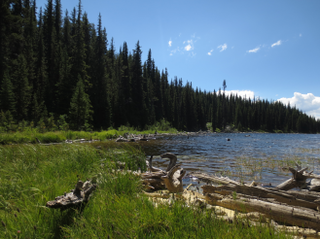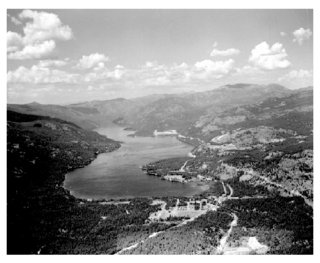
Kalamalka Lake is a large lake in the interior plateau of southern central British Columbia, Canada, east of Okanagan Lake. The lake is located approximately 4 kilometres (2.5 mi) south of the city of Vernon and is its main drinking water supply. The lake is named after the Okanagan First Nation chief who occupied its northern shores.
Arrow Lakes Provincial Park is a provincial park in British Columbia, Canada.
Babine Lake Marine Park is on Babine Lake, which borders the Skeena and Omineca regions of central British Columbia. This provincial park comprises six separate sites around the lake. Vehicle access to the lake, via BC Highway 16 and Nilkitkwa forestry service road, is by road about 105 kilometres (65 mi) northeast of Smithers; via BC Highway 16 and Central Babine Lake Highway, is about 132 kilometres (82 mi) east of Smithers; or via Babine Lake Road, is about 20 kilometres (12 mi) northeast of Burns Lake.

Beaumont Provincial Park is a provincial park located at the southeast end of Fraser Lake, between Fort Fraser and the town of Fraser Lake, British Columbia, approximately 40 kilometres (25 mi) west of Vanderhoof, British Columbia. The park contains the site of the original Fort Fraser.

Browne Lake Provincial Park is a provincial park in British Columbia, Canada, located 22 km east-southeast of Kelowna in the Okanagan Highland, near Big White Ski Resort and between the heads of Hydraulic and Grouse Creeks.
Bridge Lake Provincial Park is a provincial park in British Columbia, Canada. It is located at the eastern end of the lake of the same name, adjacent to the community of the same name, which is the largest community on the Interlakes Highway. It was established in 1956, and a merge with the nearby Bridge Lake Centennial Park in 2004 and another expansion in 2013 brought the park to its current size.
Callaghan Lake Provincial Park is a provincial park in British Columbia, Canada, located in the upper Callaghan Valley to the west of the resort town of Whistler. The dormant volcano Mount Callaghan overlooks the lake on its north side, while just to the south of the park is the sliding events facility for the 2010 Olympics.

Vaseux Lake Provincial Park is a provincial park located along the northeastern shore of Vaseux Lake in the Okanagan region of British Columbia, Canada. The park is situated 4 kilometres (2.5 mi) south of Okanagan Falls on Highway 97 in the south Okanagan. The park plays a key role in educating and providing access to important conservation values and has a responsibility to maintain these activities.
Ed Bird – Estella Lakes Provincial Park is a provincial park in British Columbia, Canada.

Fintry Provincial Park and Protected Area, also known as Fintry Estate, is a provincial park located in the town of Fintry, British Columbia, Canada. It is situated approximately 34 kilometres north of Kelowna and 49 kilometres south of Vernon on the westside of the Okanagan Lake.

Lac La Hache Provincial Park is a provincial park in British Columbia, Canada, located on lake and near community of the same name in the South Cariboo region of that province.

Lakelse Lake Provincial Park is a provincial park in British Columbia, Canada, located just west of Highway 37 between Terrace and Kitimat. The name is derived from the Coast Tsimshian language word "LaxGyels" - "fresh water mussel", for the mollusk that is found on the bottom of both Lakelse Lake and Lakelse River. Before Lakelse Lake became a provincial park, Hatchery Creek, which runs throughout the park, was the site of a sockeye salmon hatchery operated by the Canadian Government between 1919 and 1936. Lakelse Lake Provincial Park was established on March 16, 1956.

Marble Canyon Provincial Park is a provincial park in British Columbia, Canada, established in 1956 to protect Marble Canyon, a limestone formation at the south end of the Marble Range. In 2001 the park was expanded to 355 hectares to include all of Pavilion Lake due to the presence of microbialites, a type of stromatolite important to research into astrobiology and other fields, and in 2010, it was further expanded to 2,544 hectares.

McConnell Lake Provincial Park is a provincial park in British Columbia, Canada, located near Lac Le Jeune between Kamloops and Merritt, near BC Highway 5.

Nickel Plate Provincial Park is a provincial park in British Columbia, Canada. Formerly known as Clearwater Park, it is located in the Similkameen District at the northeast corner of Nickel Plate Lake. The park is also 29km northeast of Hedley near the Apex Ski Resort.
Norbury Lake Provincial Park is a 97-hectare (240-acre) provincial park in British Columbia, Canada.

Rolley Lake Provincial Park is a provincial park in British Columbia, Canada. It is located on Rolley Lake in the Stave Falls area of Mission, British Columbia. The area was inhabited by the Sto:lo people, homesteaded in 1888 by James and Fanny Rolley, and later used for logging operations. The park now provides campsites, use of the lake, and hiking, with an area of 115 hectares.

Christina Lake is an unincorporated recreational area in the Boundary Country of the West Kootenay region of British Columbia, Canada. It is located on Crowsnest Highway, 20 kilometres (12 mi) east of Grand Forks and 73 kilometres (45 mi) southwest of Castlegar.

Mount Seymour Provincial Park is a park in Vancouver, British Columbia's North Shore Mountains. With an area of 35 square kilometres, it is located approximately 15 kilometres north of Downtown Vancouver. The park, named after Frederick Seymour, was established in 1936. Mount Seymour Provincial Park provides visitors with a variety of recreational activities and animals with natural habitat.














